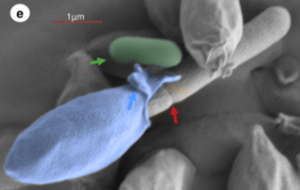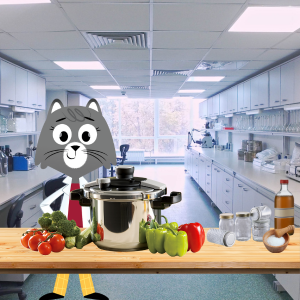Dear Macmillan,
There are some amazing deadly things out there. Like a frog that oozes poison from its skin. Or a jellyfish that uses itty bitty hooks to inject venom into its prey.
But it turns out the most poisonous thing on Earth is everywhere. It’s in our soil. It’s in our water. It might be in your kitchen.
It’s a species of bacteria called Clostridium botulinum.
I talked about it with my friend Susie Craig. She studies food safety at Washington State University.
She told me that C. botulinum makes the toxin that causes botulism. People can get it by eating food that wasn’t preserved the right way.
“I don’t think people recognize how powerful the toxin from Clostridium botulinum really is,” Craig said.
Botulinum toxin targets the place where nerves and muscles talk to each other. It blocks a chemical the muscles need to work. Without it, they get weak, droopy and paralyzed. It can be deadly if it affects the muscles we use to breathe.
Luckily, there’s an antitoxin for botulism. It grabs the toxin still traveling in the blood. But it doesn’t reverse any damage. So, people may need medical care to keep them breathing while they recover.
So, how does that bacteria get into preserved foods?
C. botulinum thrives in places with low oxygen—called anaerobic. When there’s too much oxygen or other unfavorable conditions, it forms a spore. That’s a hard, protective coating that encases the bacteria. It can stay safe inside that spore for years.
When conditions are just right, C. botulinum sheds its spore coat. It becomes active again. It starts making botulinum toxin.

This is a microscope photo of C. botulinum becoming active. The green is a bacteria cell that’s already free of the spore coating. The blue is the spore coating coming off another cell. Kathryn Cross CC BY 4.0, colorized by Dr. Universe
Let’s say we want to can green beans from our garden. But we don’t bother to look up the food safety rules for preserving them. We just drop our jars in boiling water to seal them.
Spoiler: this is a rotten plan.
Green beans are a low-acid veggie—which C. botulinum likes. The space inside our sealed jar is low oxygen—which C. botulinum loves. If our green beans have spores on them from the soil, boiling water won’t get the jar hot enough to kill them.
C. botulinum can sense our jar is cozy. It can shed the spore and start cranking out toxin. When we pop open those green beans, they’ll be poisonous.
We should have used a pressure canner. That raises the boiling point of water, so it gets hot enough to kill any spores. Or we could have frozen our green beans instead.

This is a pressure canner. It has a gauge on top. It cranks up our green beans to a balmy 240°F—instead of a measly 212° F from boiling.
You don’t have to worry about canned food you get at the store—unless it’s super dented, puffy or leaking. We have strict food safety rules to make sure companies do it right.
Craig told me it’s totally safe to preserve food at home as long as we follow the rules.
“You’re at risk for botulism if you preserve food with an untested recipe, especially if the food has a relatively low acid content,” she said. “You should use recipes from the National Center for Home Food Preservation.”
There’s one more food safety rule for avoiding botulism. Never feed honey to a baby.
Sometimes bees bring C. botulinum back to the colony. It winds up in their honey—which is no big deal for people with strong immune systems. But babies are still building theirs, so it can make them sick.
And there’s nothing sweet about that.
Sincerely,
Dr. Universe